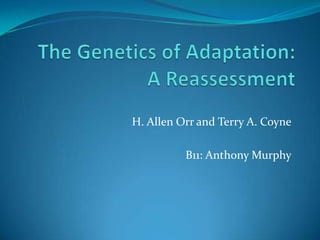
Final Senior Presentation
- 1. The Genetics of Adaptation: A Reassessment H. Allen Orr and Terry A. Coyne B11: Anthony Murphy
- 2. The Goal Review the theory and data supporting the claim that adaptation results from accumulation of many alleles of small effect Show that there is no real solid data to back up this claim With the introduction of molecular approaches, there might be the ability to resolve this problem in the future
- 3. Micro-mutationism Originated with Charles Darwin Darwin and followers believed evolution of adaptive systems happened in substitution of many genes of small effect Darwin wrote “We have many slight difference which may be called individual differences…..these differences are important for us, as they afford materials for natural selection”
- 4. Macro-Mutationalism Originated with T.H. Huxley, a colleague of Charles Darwin Huxley and followers believed that adaptive evolution takes place in large steps with no intermediate steps Huxley wrote: “Mr. Darwin’s position might..have been stronger than it is if he had not embarrassed himself with the aphorism, ‘Natura non facit saltum’…We believe that Nature does make jumps now and then, and recognition of the fact is of no small importance in disposing of many minor objections to the doctrine of transmutation.”
- 5. R.A Fisher Champion of the Micro-mutationism Theory Argued that adaptation involves “conformity of parts” of the system Large Random Change would cause “worsening of function” He believed large mutations have a very small changes of being favorable
- 6. Fisher’s Microscope Analogy Consider a microscope a system for adaptation A large change will almost always worsen the focus in an ideal microscope However, small changes are less likely to harm the focus and might improve it
- 7. Fisher’s Sphere Example Arrangement of parts giving the highest fitness is the center of the sphere A species’ present position can be represented by a part of the sphere surface Any displacement inside the sphere improves adaptation Any displacement outside the sphere worsens adaptation
- 8. Why Fisher is Incorrect Fisher shows only that small mutations are more likely to be favorable, not that they are more likely to be substituted The substitution rate of a class does not depend only on the chance of it being advantageous, but also on the mutation rate and fixation rate (According to Kimura) Fisher’s argument does not apply to cases in which an adaptive landscape has more than one single peak Fisher assumes that all mutations have a similar effect on fitness no matter how they interact in the body
- 9. Lande (1983) Concluded that, unless selection is very strong and persistent, adaptation will usually result from substitution of micromutations. Explains why artificial selection or selection in disturbed populations usually fix mutations of large affect while natural selection fixes polygenes
- 10. Problems with Lande’s Model It is considered, by the authors, to be an improvement over Fisher, but still has problems It is not clear that evolution in nature usually involves selection toward an ideal form Lande’s theory also may have features that predispose it against the fixation of large mutations However, it should be pointed out that no model can answer the question of relative importance between major or minor genes.
- 11. Frequency of Major and Minor Mutations The rate of substitution of major genes depends on how often they are produced by mutation It is also said that mutations with small effects arise more often than those with major effects There are many individuals who support the claim that mutations affecting viability Only one (Gregory) investigated whether the same is true for genes affecting morphology
- 12. Gregory (1965) Compared the phenotypes of peanut plants descended from seeds irradiated by X Ray and control plants Concluded that mutations of large phenotypic effect are far rarer than small effect mutations
- 13. Problems with Gregory No evidence that the mutations were genetic, Assessment of effects was not the same between the two experimental variables The experiment was bias against the recovery of large mutations
- 14. Genetic Analysis of Adaptation Artificial Selection- Selection for traits in breeding Disturbed Populations in Nature- Pioneer Species, Resistance to environment, Arms race Adaptations in Natural Populations- Batesen and Mullerian Mimicry Differences among Species and Subspecies- Genetic Difference between species of organisms
- 15. Future Research There are only a few genetic analyses of species differences that are clear adaptations While some adaptations are based on genes of small effect, sometimes major genes are involved Traditional approaches can’t answer the central question Must use genetic factors such as linkage and chromosome analysis
- 16. Conclusion They found little support that adaptation always involves genes of small effect It has been found that major gene effects are not as rare as they were once thought There is a need in the near future to perform more genetic studies of adaptation